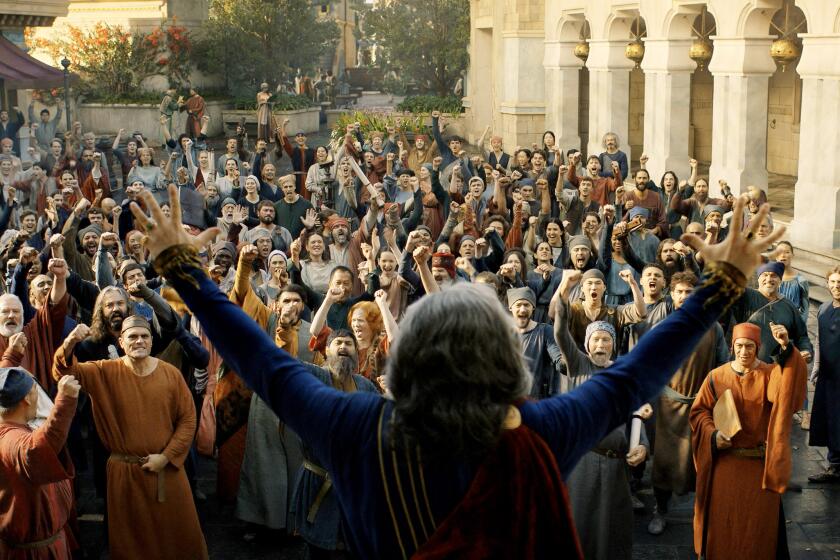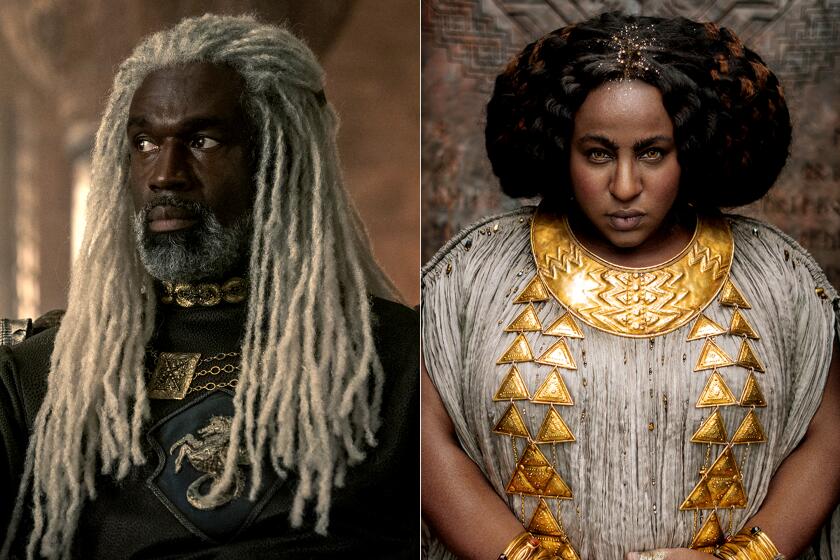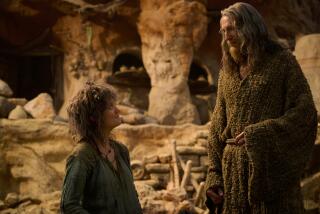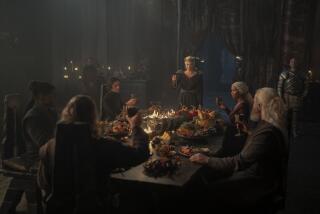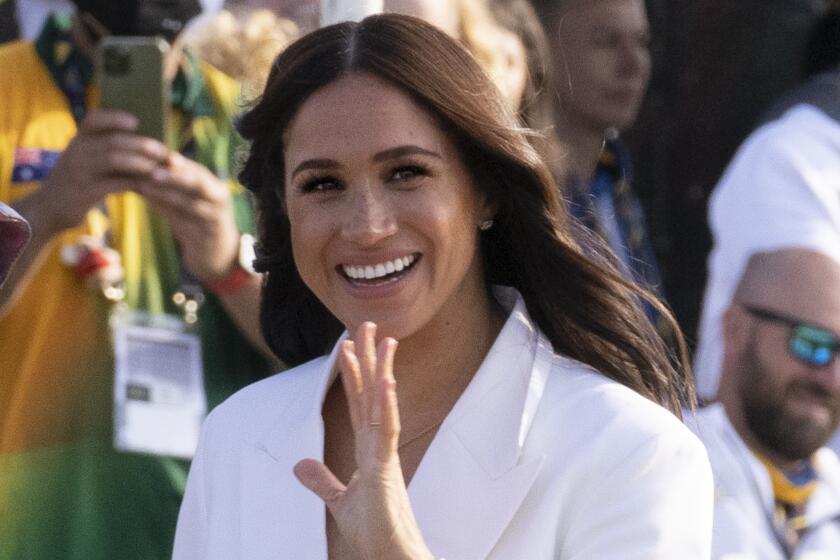Many predicted Amazon’s ‘Lord of the Rings’ prequel would be a disaster. It isn’t
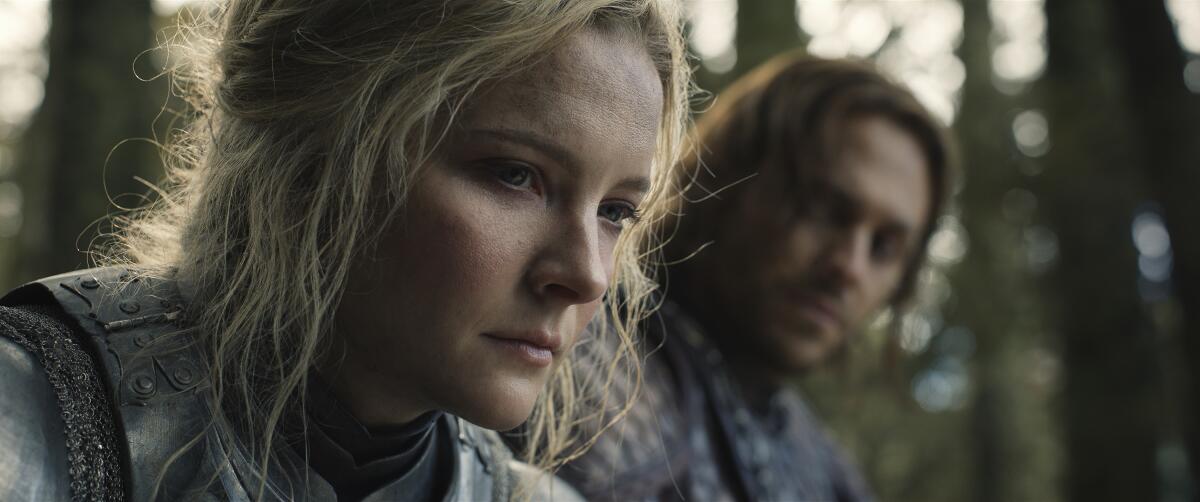
- Share via
And so it came to pass, in the 21st year after the arrival of “The Lord of the Rings: The Fellowship of the Ring” — and eight years after “The Hobbit: The Battle of the Five Armies,” the conclusion of its prequel trilogy — that a prequel prequel was mounted upon Amazon’s Prime Video in the form of a television series: “The Lord of the Rings: The Rings of Power.” And even before its substance was revealed to the populace, except in teasers and trailers and sundry con panels and promotional videos, there was much dissension in the land over the question of whether it would prove a force for good or for evil.
To judge by the vlogosphere, “force for evil” is the predominant view. Titles of videos up on YouTube include “The Rings of Power is D.O.A.,” “Why Everyone Hates The Rings of Power … Already,” “The Rings of Power Is Going to Suck,” “How ‘The Rings of Power’ Should Have Been Written” and “Rings of Power is a PARODY of ‘Lord of the Rings,’” all based on a smidgen of evidence.
Well, I have seen six of the first season’s eight episodes, and “The Rings of Power” is neither a disaster nor a triumph, merely television of a visibly expensive, fitfully inspired sort. It looks good, has a few charismatic performances that sell the characters and is all in all watchable, if something less than compelling — predictable even in the suspenseful parts, occasionally exciting and sometimes sort of boring. Action scenes, which kept the movies lively, and do get your attention here, are relatively spread out, perhaps because they’re expensive and the season is long.
Amazon has spent more than $700 million for the first season of “The Lord of the Rings: The Rings of Power,” a high priority for founder Jeff Bezos.
Some might find it disqualifying, but I do not care a whit how much the series departs from the source material, which is sketchy at best — taking place a time long before Frodo set off for Mt. Doom, it is largely based on the novel’s appendices — or even whether it is in the “spirit of Tolkien,” whatever that means to any individual reader. That male elves don’t all have long hair, as they do in the books and the movies, is not something that even crossed my mind. Although many enjoy digging into the minutiae of Tolkien’s cosmological, historical and anthropological appendices, what matters is whether the series tells a good story — or stories, since there are several, whose intercutting does tend to take a little power out of the narrative. And my verdict on that point is … here and there it does. Now and again. Some storylines work better than others.
At the same time, the allure of Peter Jackson’s six films, adapting the whole of Tolkien’s pre-posthumous works, was not just in the narrative but the production itself, the unprecedented effort put into bringing a fantasy world to intricately rendered life, whether through special effects or remarkable craftsmanship. As do the “Lord of the Rings” films, “The Rings of Power” functions as a kind of imaginary travelogue, carrying the viewer through diverse environments and settings and cultures and color palettes, here including the Atlantis-esque island of Númenor, imagined in a Greco-Roman-Egyptian style new to the franchise. And in this respect, “The Rings of Power” is an enjoyable ride.
If you object to characters of color in “House of the Dragon” and “The Rings of Power,” you’re missing the point and revealing your racism.
The series is entirely conventional, but “LOTR” is itself conventional. For all its narrative digressions and the wayward progress of its characters, separated and reunited, Tolkien’s two novels are pretty straightforward: Little creatures set off on a quest while bigger creatures work to protect them and a wizard comes and goes. It’s “The Wizard of Oz” with battle scenes, if the Lion were trying to kill Dorothy and steal the ruby slippers.
So what’s up in the Second Age of Middle-earth, thousands of years before the Third Age doings of “The Hobbit” and “The Lord of the Rings”? Things have been quiet, except in the mind of Galadriel (Morfydd Clark), who will grow up to be Cate Blanchett; against the common wisdom, she’s convinced that Sauron, that shadowy personification of evil, is growing in strength, and as commander of the Northern Armies she is obsessively pursuing him to the frostbound ends of Middle-earth — even as the current Elven administration is ready to pull back its defenses, proclaiming peace in their time. Out in the forests and fields, a peripatetic group of Harfoots (like Hobbits, but not Hobbits, or not yet Hobbits), under the guidance of Sadoc Burrows (Lenny Henry), are living a life of Irish-brogue comic relief.
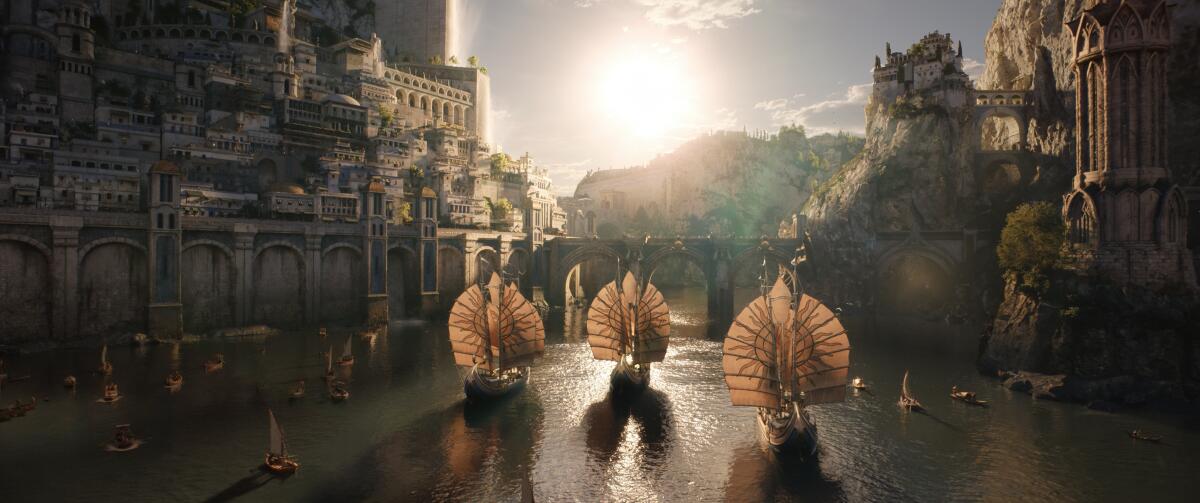
Arondir (Ismael Cruz Córdova), a sort of elf sheriff, a taciturn classic Western type, has his eye shyly on the human healer Bronwyn (Nazanin Boniadi), a single mom with a teenage son, Theo (Tyroe Muhafidin). (Elves are not taken kindly to in those parts.) Half-human elf Elrond (Robert Aramayo), who is later to run things in Rivendell but for the moment is not up to much of anything, is sent to work with the ambitious master smith Celebrimbor (Charles Edwards), who dreams of a giant forge with “a flame as hot as a dragon’s tongue and as pure as starlight.” In order to get the work done “by spring” (it does feel arbitrary), Elrond goes to enlist the help of the dwarves, only to find his old friend Prince Durin IV (Owain Arthur) miffed that it’s taken 20 years for Elrond to to look in on him and meet his wife (Sophia Nomvete).
The series is very much the stepchild of the films, shot again in New Zealand, borrowing their look, their Howard Shore-composed theme, their “Carmina Burana”-style musical cues. (Bear McCreary is the series’ composer.) There are maps, happily. The tropes are familiar. Nori Brandyfoot (Markella Kavenagh), a young Harfoot with a taste for adventure, more or less stands in for Bilbo or Frodo, a small person fate has chosen for big things. The forbidden love between an elf and a human represented by Arondir and Bronwyn is a bit of Aragorn and Arwen. Halbrand (Charlie Vickers), whom Galadriel meets shipwrecked in the middle of the Sundering Sea, is, like Aragorn in his ranger wear, a monarch in disguise; as soon as he says, “My people have no king,” you 100% know he’s it. (There’s a bit of Viggo Mortensen about Vickers as well.) Theo happens upon the hilt of a broken sword that possesses some dark magic and which one supposes might eventually possess him, echoing Sauron’s master Ring, which as of this telling does not yet exist. And as in “The Lord of the Rings,” the necessary cooperation of the mutually suspicious virtuous races of Middle-earth — men, elves, dwarves and Harfoots — to battle a rising evil is a theme. (No wizards appear in the episodes out for review, unless that man who fell to Earth inside a meteor — Daniel Weyman as the Stranger — turns out to be one.)
With the price tag for five seasons expected to reach $1 billion (the rights alone cost $250 million), it‘s predicted to be the most expensive television series ever. It’s true that Jeff Bezos could pay for the whole thing out of his own pocket without the slightest dent in his lifestyle, but it’s safe to assume Amazon is not in this to lose money, and in order to make back its nut— or simply not be deemed a failure — “The Rings of Power” is going to have to attract not only fans but people who have never read the books or even seen the movies. It has to be intelligible to the less informed, which means smoothing out the action, cutting extraneous details (though some would consider no detail extraneous) and keeping relations between characters and kingdoms at least a little obvious and easy to read. Showrunners J.D. Payne and Patrick McKay have done this, and you can hardly blame them.
The Times TV team is back together for another fall season. Here are the 20 new and returning shows we’re most excited for.
The thing about intellectual property is that it is property, controlled by whomever paid for it last. If they want to rip down a nice old house and put up a McMansion, nobody can stop them, as much as the neighborhood might protest. Tolkien sold the right to adapt “The Hobbit” and “The Lord of the Rings” back in 1969; in 2017, Amazon paid his estate for the rights to the appendices and any references to the Second Age in the trilogy. (The estate is a producing partner.) It is left to the legions of fans to defend the works on the plains of social media, like Éomer and Aragorn at the Battle of the Pelennor Fields. However much good that will do them.
And sometimes (some) fans defend the wrong things, as when attacking the production for its foregrounding of female roles and casting actors of color where Tolkien (and Jackson, following his lead) only saw white. Evidence has been advanced to show that Tolkien was anti-racist in life, but there is no getting around the fact that in his books, Northern European types save the day from swarthy types from the South and East, who are characterized with giant elephants and (as in Jackson’s “The Return of the King”) quasi-Arabic garb. To be honest, I was a little worried the series would continue in that distasteful vein and happy to see that it did not; Tolkien, some would say, was just a man of his time, but these are different times. (I reject out of hand all arguments that employ the word “woke” or use “diversity” in a negative sense.) “The Rings of Power” does, in a few instances, too obviously adopt the language of modern American prejudice to make a point, but that is a matter of poor writing rather than a bad idea.
And as for women in “The Rings of Power” — and Jackson, let’s recall, memorably put a sword in Liv Tyler’s hand in “The Fellowship of the Ring” and invented a female elf warrior, Tauriel, for his “Hobbit” movies — Galadriel is its most engaging character by far. Clark makes her driven yet centered, elegant yet badass. She seems to belong naturally to the time and place and looks good taking apart a snow troll. The series is never dull when she’s onscreen.
What did bother me is the fact that characters seem to traverse great distances effortlessly, in no time at all. That just feels like cheating.
‘The Lord of the Rings: The Rings of Power’
Where: Amazon Prime
When: Any time, starting Thursday
Rating: TV-14 (may be unsuitable for children under the age of 14)
More to Read
The complete guide to home viewing
Get Screen Gab for everything about the TV shows and streaming movies everyone’s talking about.
You may occasionally receive promotional content from the Los Angeles Times.
